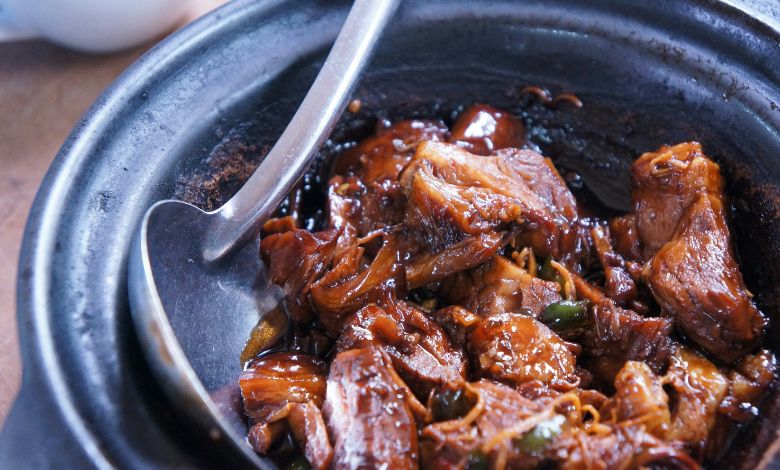Bảie: What You need to Know (Full Review Included)

Bảie is a delightful fusion of tradition and innovation that showcases the true essence of Vietnam’s rich gastronomic heritage.
If you’re a food lover seeking an adventure for your senses, then Vietnamese cuisine is sure to captivate your palate.
In this blog post, we will delve into the depths of Bảie and unravel its fascinating history, explore the key ingredients that make it unique, uncover traditional dishes with their intriguing origins, discover regional variations that add diversity to its repertoire, and even venture into modern twists on classic recipes. So fasten your seatbelt as we embark on a flavorful odyssey through the world of Bảie.
So get ready to awaken your taste buds and open yourself up to new culinary horizons as we embark on our exploration of everything there is to know about Bảie. You won’t be able to resist trying these mouthwatering delights once you’ve learned all about them. Let’s begin!
History of Vietnamese Cuisine
Centuries of history and cultural influences have shaped Vietnamese cuisine into a rich and diverse culinary tradition.
Early Vietnamese people, in the prehistoric era, traced their origins to relying on fishing, hunting, and gathering for their meals.
During this period, Chinese cooking techniques and ingredients were introduced to Vietnam, including soy sauce, tofu, and stir-frying methods.
In the 19th century, French colonization left an indelible mark on Vietnamese cuisine. The French brought with them baguettes (banh mi), coffee culture (ca phe), and pastries like croissants (banh bao).
Despite these foreign influences, Vietnamese cooking has managed to maintain its distinct flavors. It’s emphasis on fresh ingredients such as herbs like:
- Mint and cilantro
- Fish sauce for umami flavor
- Lemongrass for fragrance
- Lime juice for acidity
Today, Vietnamese cuisine harmoniously blends indigenous practices with influences from China, France, Thailand, and Cambodia. This combination creates unique dishes that tantalize taste buds around the world.
So next time you savor that bowl of pho or bite into a banh mi sandwich filled with deliciousness. Remember it’s not just food on your plate but a reflection of Vietnam’s vibrant culinary history.
Key ingredients used in dishes
Bảie cuisine is renowned for its bold and vibrant flavors. Which are achieved through the skillful use of a few key ingredients. These ingredients form the foundation of many traditional Bảie dishes, lending them their distinctive taste and aroma.
One such ingredient is fish sauce, or “nuoc mam,” which is used as a base in numerous Bảie recipes. Made from fermented fish and salt, it adds depth and umami to dishes like pho and bun cha.
Another essential ingredient is rice noodles, commonly known as “bun” or “pho.” These thin strands of rice flour provide the perfect canvas for absorbing the rich flavors of broths and sauces.
Fresh herbs also play an integral role in Bảie cuisine. Fragrant varieties such as Thai basil, cilantro, mint, and perilla leaves add brightness and freshness to dishes like spring rolls and banh mi sandwiches.
Vietnamese cuisine also relies heavily on vegetables such as bean sprouts, cabbage, carrots, daikon radish, and cucumbers. These crunchy additions bring texture to soups, salads,and stir-fries while providing a refreshing contrast to richer flavors.
Lastly,sauces like hoisin sauce,tamarind paste,and chili sauce contribute tanginess,sweetness, and spiciness respectively.
These condiments elevate each bite,giving Bảie dishes their signature balance of flavors.
Bảie cuisine combines these key ingredients with expert technique,resulting in harmonious,fresh,and flavorful dishes that have captivated food lovers worldwide.
Explore this culinary treasure trove yourself,dive into the diverse world of Vietnamese gastronomy.
Traditional Bảie dishes and their origins
Traditional Bảie dishes are a delightful showcase of Vietnamese culinary traditions and flavors. These dishes have their origins deeply rooted in the rich history and cultural heritage of Vietnam.
One such dish is pho, which is perhaps the most famous Vietnamese dish worldwide. Pho originated in Northern Vietnam and consists of rice noodles served in a flavorful beef or chicken broth, garnished with herbs, lime wedges, bean sprouts, and chili.
Another iconic Bảie dish is banh mi, a delicious sandwich that combines French and Vietnamese influences.
It features a crusty baguette filled with various ingredients like pork belly, pate, pickled vegetables, cilantro, and chili sauce. The fusion of French-style bread with traditional Vietnamese fillings makes banh mi truly unique.
One popular Bảie dish from Central Vietnam is cao lau. Made with thick rice noodles topped with slices of BBQ pork, fragrant herbs like mint and basil leaves, crunchy bean sprouts,and crispy croutons made from fried rice paper,it creates an explosion of textures and flavors.
Moving towards Southern Vietnam,Bảie offers the vibrant dish called bun bo Hue.
A spicy beef noodle soup originating from Hue,this aromatic soup incorporates lemongrass,chili,pork hocks,and shrimp paste to create its distinct flavor profile.
These examples showcase the diverse range of traditional Bảie dishes found throughout Vietnam. Specific regions within the country trace their origins, and each dish has its unique combination of ingredients, sauces, and spices that make it stand out.
With every bite,you can savor centuries-old recipes passed down through generations,filled with authenticity,charm,and mouth-watering deliciousness
Regional variations in Bảie cuisine
Vietnamese cuisine is known for its diverse regional variations, and Bảie dishes are no exception. From the bustling streets of Hanoi to the floating markets of the Mekong Delta, each region adds its own unique twist to traditional Bảie recipes.
In Northern Vietnam, you’ll find a strong influence from China with dishes like “phở bắc,” a lighter version of the famous beef noodle soup. The broth is clear and fragrant, typically served with thinly sliced rare beef or chicken.
Central Vietnam is renowned for its spicy flavors and vibrant colors. Here, you’ll encounter dishes like “bún bò Huế,” a spicy beef noodle soup that packs a punch with chili oil and lemongrass.
In Southern Vietnam, where the climate is hot year-round, coconut milk plays an essential role in many dishes. “Bánh xèo” is a popular crispy pancake filled with shrimp, pork, bean sprouts, and served alongside fresh herbs for wrapping.
Each region showcases different cooking techniques and ingredients based on their local produce and cultural influences. Exploring these regional variations allows you to truly experience the rich tapestry of Vietnamese cuisine!
Remember to stay tuned for our full review of one specific restaurant’s take on Bảie dishes.
Fusion dishes and modern twists on traditional Bảie
Fusion dishes and modern twists on traditional Bảie have become increasingly popular in recent years, as chefs experiment with new flavors and techniques to create unique culinary experiences. These innovative creations combine elements of traditional Vietnamese cuisine with influences from other cuisines around the world.
One example of a fusion dish is the Banh Mi Burger, which takes the classic Vietnamese sandwich and transforms it into a mouthwatering burger. The juicy patty is often made with pork or beef marinated in traditional Bảie spices, topped with pickled vegetables, cilantro, and spicy mayo all served on a fluffy baguette.
Another popular modern twist on Bảie is the Pho Salad. This refreshing salad combines the flavors of a traditional Pho soup with fresh greens, herbs like mint and basil, bean sprouts, sliced beef or chicken (or even tofu for vegetarians), all tossed together in a tangy dressing.
For those craving something sweet, there’s also the Coconut Pandan Cake – an indulgent dessert that blends fragrant pandan leaves with creamy coconut milk to create a moist cake that’s simply irresistible.
These innovative dishes not only showcase the creativity of chefs but also highlight how Vietnam’s rich culinary traditions can be adapted to suit contemporary tastes. So if you’re looking for something new and exciting to try while exploring Vietnamese cuisine, don’t hesitate to dive into these fusion dishes and discover a whole new world of flavors!
Popular restaurants and street food vendors
When it comes to experiencing the vibrant flavors of Bảie, Vietnam offers a plethora of options. From high-end restaurants to humble street food vendors, you will find a myriad of establishments serving delicious Bảie dishes.
Hanoi and Ho Chi Minh City
In bustling cities like Hanoi and Ho Chi Minh City, you’ll discover renowned establishments such as Nha Trang Xua Restaurant and Quan An Ngon. These restaurants not only serve authentic Bảie cuisine but also provide an immersive dining experience with their charming ambiance.
For those seeking an adventure through the local streets, don’t miss out on exploring the lively food markets and food stalls that line the alleys. Places like Ben Thanh Market in Ho Chi Minh City or Dong Xuan Market in Hanoi are treasure troves for discovering mouthwatering Bảie street food delights.
You must try Banh Mi, a Vietnamese sandwich filled with various savory ingredients such as grilled meats, pickled vegetables, fresh herbs, and pate; it is one popular dish. You can easily find this tasty treat at small carts dotted along busy streets throughout Vietnam.
If your taste buds crave something soupy and comforting, head to Pho 24 or Pho Thin where you can indulge in bowls of steaming hot pho – a traditional Vietnamese noodle soup bursting with flavors from aromatic herbs and tender beef or chicken.
For seafood lovers longing for a feast by the sea, make your way to coastal cities like Da Nang or Nha Trang where numerous seafood restaurants offer delectable dishes made from freshly caught fish and shellfish.
Whether you opt for upscale restaurants or delve into the vibrant street food scene in Vietnam’s cities, brace yourself for an explosion of flavors that will leave you craving more.So grab your chopsticks or use your hands (as locals do) – whatever your preference may be – dive into the world of Bảie cuisine!
Tips for trying Bảie and exploring Vietnamese cuisine
When it comes to trying Bảie and exploring Vietnamese cuisine, there are a few tips that can enhance your experience. First and foremost, be adventurous! Don’t stick to the familiar dishes you already know – step out of your comfort zone and try something new. Vietnamese cuisine is known for its bold flavors and unique combinations.
One tip is to start with the basics. Familiarize yourself with key ingredients used in Bảie dishes, such as fish sauce, lemongrass, ginger, and rice noodles. Understanding these foundational elements will give you a deeper appreciation for the complexity of flavors in each dish.
Another tip is to explore regional variations within Vietnam. Each region has its own specialties and cooking techniques that make their dishes distinct. Discover a wide range of flavors, from fragrant pho in Hanoi to spicy bun bo Hue in central Vietnam.
Don’t forget about street food! Small stalls or carts lining the streets of Vietnam’s cities offer some of the best culinary experiences. These vendors often serve up delicious Bảie dishes bursting with flavor at affordable prices.
Don’t be afraid to ask locals for recommendations. They will have insider knowledge on where to find the most authentic and delicious Bảie dishes. Engage with them, strike up conversations about food, and let their passion guide you on your culinary journey through Vietnam.
Remember, trying Bảie is not just about filling your stomach – it’s an opportunity to immerse yourself in Vietnamese culture through its vibrant cuisine. So go ahead – embrace adventure, savor every bite, and let your taste buds take you on a flavorful journey through Vietnam!
Full review of a specific Bảie restaurant
Nestled in the bustling streets of Hanoi, Bảie is a hidden gem that promises to take your taste buds on an unforgettable journey through Vietnamese cuisine. With its cozy ambiance and authentic flavors, this restaurant truly captures the essence of traditional Bảie dishes.
As I stepped into Bảie, I was immediately greeted by the warm smiles of the staff. The menu boasted an impressive array of dishes, ranging from classic favorites to unique creations. Unable to resist my curiosity, I decided to start with their renowned Pho Bo – a hearty beef noodle soup that is synonymous with Vietnamese cuisine.
Each spoonful delivered a burst of flavors – tender slices of beef, fragrant herbs, and perfectly cooked rice noodles swimming in a rich broth. It was evident that every ingredient had been carefully selected and prepared with precision.
Next up was Banh Xeo – a crispy pancake filled with succulent shrimp and fresh bean sprouts. The combination of textures made each bite incredibly satisfying. Paired with Nuoc Cham dipping sauce, it created an explosion of flavors in my mouth.
For those seeking something adventurous, Bảie offers innovative fusion dishes like their Grilled Lemongrass Pork Belly Tacos. This marriage between Mexican street food and Vietnamese spices was a true revelation for my taste buds – smoky pork belly complemented by tangy pickles wrapped in soft tortillas.
The attentive service at Bảie further enhanced my dining experience. The waitstaff were knowledgeable about each dish and readily offered recommendations based on personal preferences.
My visit to Bảie left me craving more delicious bites from their extensive menu. From traditional classics to modern fusions, this restaurant has mastered the art of balancing flavors while staying true to its Vietnamese roots.
Conclusion
As we conclude this exploration into Bảie and Vietnamese cuisine, it’s evident that a world of flavors awaits discovery. Bảie offers a culinary experience like no other, from its rich history to the vibrant ingredients used in traditional dishes.
Immerse yourself in an incredible journey of Vietnamese cuisine, filled with bold flavors, fresh ingredients, and cultural nuances. So grab your chopsticks and get ready to savor every bite as you dive into the world of Bảie!
FAQ’s
1. What is Bảie?
Bảie is a traditional Vietnamese cuisine that showcases the unique flavors and culinary techniques of Vietnam. It encompasses a wide range of dishes, from aromatic soups to flavorful stir-fries and delicate rice paper rolls.
2. What are some key ingredients used in Bảie dishes?
Some common ingredients used in Bảie dishes include fish sauce, lemongrass, fresh herbs like mint and cilantro, shrimp paste, rice noodles, tofu, bean sprouts, and various types of meat such as pork or beef.
3. Are there any vegetarian options available in Bảie cuisine?
Yes! Vietnamese cuisine offers several vegetarian-friendly options in its repertoire. You can find delicious plant-based dishes like vegetarian pho (noodle soup), crispy spring rolls filled with vegetables and tofu, or banh mi sandwiches loaded with pickled veggies.
4. How does regional variation impact Bảie cuisine?
Vietnam has diverse regional cuisines that vary based on geography and local traditions. For example, Northern Vietnamese cuisine tends to be more mild and influenced by Chinese flavors while Southern Vietnamese cuisine showcases spicier tastes influenced by Cambodian and Thai cuisines.
5. Where can I try authentic Bảie food?
There are many popular restaurants both within Vietnam and around the world that specialize in serving authentic Bảie cuisine. Some renowned establishments include Xoi Yen in Hanoi for sticky rice dishes or Quan An Ngon in Ho Chi Minh City for an extensive menu featuring various specialties from different regions of Vietnam.
6. Can you recommend any street food vendors for trying out Bảie?
If you’re looking for an immersive street food experience when trying out Bảie dishes, consider visiting places like Ben Thanh Market in Ho Chi Minh City or Dong Xuan Market in Hanoi where you’ll find numerous stalls selling delectable local delicacies at affordable prices.



